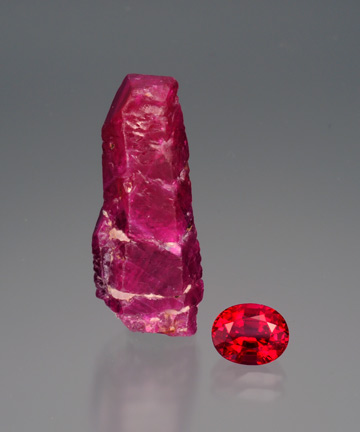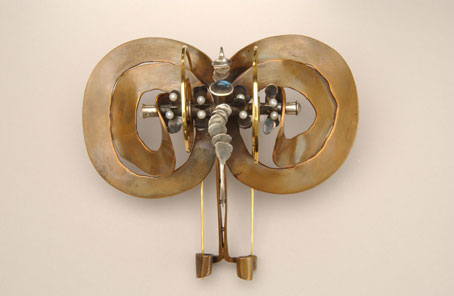gem-news-2008-v1

January – April 2008
- Other April News – Apr 25
- April 2008 Newsletter – Apr 20
- March 2008 Newsletter – Mar 19
- February 2008 Newsletter – Feb 21
- Other February News – Feb 8
- January 2008 Newsletter – Jan 16
Other April News
April 25: 100-Carat Diamond Offered in Christie’s Sale
The largest colorless diamond to be auctioned in 18 years will be offered May 28, according to a Christie’s Hong Kong press release.
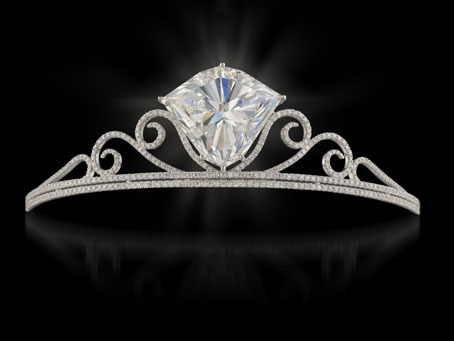 |
| Nameless. The 101.27-carat diamond in this tiara comes with “naming rights.” (Photo: Christie’s) |
The stone was cut from a 460-carat rough, the modified shield shape featuring 92 brilliant facets. Also offered at the sale is a 10.63-carat green diamond (pictured below). [back to top]
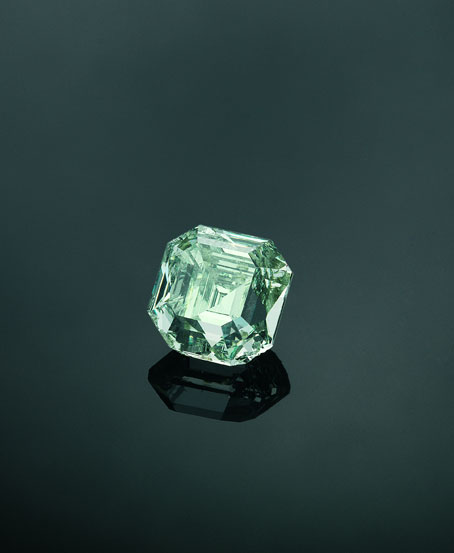 |
| Timeless. Christie’s claims that “millions of years are required to render even a pale green body colour to a 1 carat diamond.” (Photo: Christie’s) |
April 2008 Newsletter
Shows, Sales, and Symposia
- FIPP 2008 – Brazil’s “Fair At the Source”
- Christie’s Cancels Ralph Esmerian Sale
- Sixth Annual John Sinkankas Symposium: Garnet
Pala International News
Gem and Gemology News
Industry News
- Fundraising for Tanzania Miners’ Flood Relief
- Burma Bits
- 2007 Gem Trade Statistics – 89% Increase Over FY2006–07
- March Gem Emporium Sales Figures Withheld
- Bite-Sized Bits
Shows, Sales, and Symposia
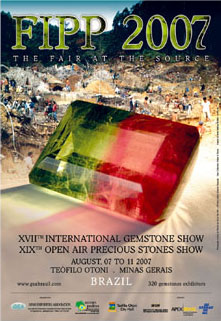 |
| The poster for last year’s fair features a bi-color tourmaline. Brazil is a major source of tourmaline. |
FIPP 2008 – Brazil’s “Fair At the Source”
August 26–30, 2008
It's not too early to plan for Brazil’s 18th annual gemstone show, Feira Internacional de Pedras Preciosas, better known as FIPP. The fair is held in the central plaza of the city of Teófilo Otoni, in the southeastern state of Minas Gerais. Teófilo Otoni is home to mines producing aquamarine, chrysoberyl, quartz varieties, and topaz.
A tour in conjunction with FIPP 2008 is available from Custom Group Tours. The tour will visit mines near the fair site as well as the cities of Governador Valadares and Ouro Preto; an extension option is available to the agate and amethyst country of the southernmost state of Rio Grande do Sul. A highlight for the diamond lover is a viewing of the crown of Emperor Dom Pedro II, featuring 629 diamonds and 77 pearls. To get a feel for the itinerary, see this report on the 2003 ICA Brazil Gem Tour. [back to top]
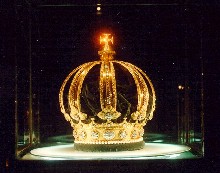 |
| The crown of Dom Pedro II is housed at the Imperial Museum at Petrópolis, an hour from Rio de Janeiro. (Photo: Petrópolis Foundation of Culture and Tourism) |
Christie’s Cancels Ralph Esmerian Sale
Court-Ordered Auction Thwarted via Bankruptcy Petition
 |
| In the pink. This 14.23-ct. diamond is amongst jewels the Esmerian family collected over three generations, according to the New York Times. (Photo: Christie’s International) |
Ralph Esmerian, on behalf of Fred Leighton and seven affiliated companies, has filed for bankruptcy protection, effectively halting an attempt by Merrill Lynch to collect outstanding debts, according to Bloomberg, April 15. Christie’s was scheduled last Tuesday to auction an estimated $34 million worth of jewelry, according to the New York Times.
The sale press release, still available on the Christie’s website, touted the offering as “the most spectacular and comprehensive collection of period jewels from the 17th century through modern day.” Christie’s Chairman of Jewellery, Françios Curiel, called the collection “unparalleled to virtually any other in the world for its provenance, breadth, size and rarity.”
Featured at the sale was an impressive 14.23-carat fancy intense pink diamond, valued at up to $15 million. The press release’s description is worth quoting:
This exquisite gem has a pure pink coloration that is even and consistent and has been awarded the color grade of “Fancy Intense Pink” by the Gemological Institute of America. The diamond is truly magnificent for both its size and absence of inclusions within its crystal. Further emphasizing its rarity is the elegant and classic rectangular cut of the diamond which is so intensely saturated with color that no additional facets were required to intensify its tone.
Unlike blue or yellow diamonds, the natural pink color is not caused by a chemical component. Although researchers disagree on what actually causes the color of natural pink diamonds, studies in the gemological field have concluded that there are two types of pink diamonds, each having a slightly different cause of color. One group, designated Type IIa, has a very pure pink color, even coloration and lack of inclusions. Type IIa diamonds are rare gems of the diamond family, which have no traces of the colorant nitrogen. The absence of this element, seen in 98% of diamonds, gives the stone a purity of color and degree of transparency that is observed only in the finest stones originating from the mines of Golconda, Brazil and South Africa.
Esmerian was quoted in the Times article as contending that the auction was a fire sale, and that private transactions would command higher prices. [back to top]
Sotheby’s Hong Kong Sale Featured Colored Diamonds
While not as spectacular as the Esmerian diamond, Sotheby’s April 10 Hong Kong sale featured three notable colored diamonds (requires free login).
- A cushion-cut fancy light pink diamond, 8.71 carats, 847,000 USD
- An oval-cut fancy deep blue diamond, 2.01 carats, 1,149,000 USD
- A radiant-cut fancy intense pink diamond, 4.45 carats, with a three-tiered border of diamonds, one tier of which is yellow, 2,011,000 USD
[back to top]
Sixth Annual John Sinkankas Symposium: Garnet
The sixth annual John Sinkankas Symposium was held over the weekend, on the topic of garnet. The event is co-sponsored by the San Diego Mineral and Gem Society and the GIA’s Liddicoat Gemological Library and Information Center.
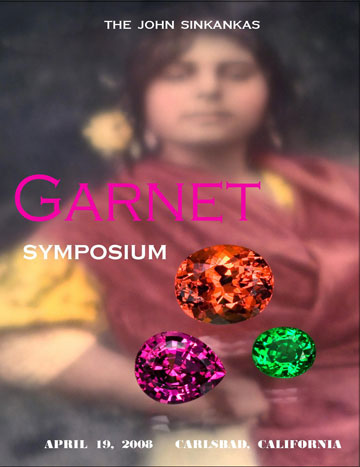 |
| Pala’s Wimon Manorotkul provided photographs for this year’s symposium booklet. The gemstones are (l–r) rhodolite, spessartite, and tsavorite garnets. |
Speakers and topics were scheduled as follows.
- Lisbet Thoreson: Garnets as Gems in Ancient Times
- Skip Simmons: Mineralogy and Crystallography
- Si Frazier: Interesting Garnet Facts
- Bill Larson: Rarer Gem Garnets
- John Koivula: Microworld of Garnet
- Meg Berry: Cutting Hints for Gem Garnets
- Robert Weldon: Gem Garnets and Photography Tips
- George Rossman: Color in Garnet
[back to top]
Pala International News
Pala’s Featured Stones: Sapphire and Ruby
Rough and Cut: From Crystal to Jewel
To stay on topic with this month’s unveiling of our new corundum collection, we though we’d highlight a ruby and sapphire rough-and-cut pair to further appreciate and visualize corundum’s different forms—the speciation of corundum, if you will, from nature’s attempt at crystal perfection to man’s final artistic push to bring out the inner brilliance and color in the faceted form. An intelligently designed crystal with a human touch; the duality of nature and man at its finest.
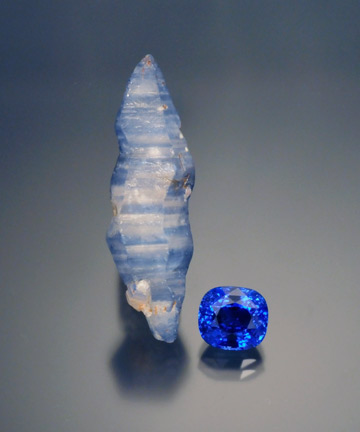 |
| Sri Lankan sapphire pair. The crystal measures 4.3 x 1.3 cm. and weighs 48.23 cts. The faceted gem measures 10.48 x 9.56 x 7.3 mm., weighs 7.13 cts., and is certified natural color from Sri Lanka. Search for the cut stone on inventory number 14737. (Photo: Wimon Manorotkul) |
Blue sapphire. A perfect pair showing the classic tapering hexagonal bipyramidal corundum crystal and its sparkling blue faceted counterpart. The white and blue color banding seen throughout the length of the crystal is quite common and often can be seen with magnification from the back of a faceted blue sapphire. The exceptional size and rich, natural royal blue hue of the sapphire definitely classifies this as an upper echelon gem.
Ruby tends to form in less euhedral crystals, as the perfect symmetry breaks down during formation. This ruby crystal shows the basic hexagonal faces with a rhombohedral termination. Clearly visible are crisscrossing bands of color and small clear pockets interrupted by a network of fractures—probably why the crystal stayed in the natural form and was not able to yield clean stones. The purity of the red hue is seen in the faceted stone, while the crystal shows a more pinkish red. Purity of color is a big factor when evaluating quality; straight red will demand a much higher price than a red with a pink secondary.
Browse the online catalog for blue sapphire and ruby:
Pala’s New Corundum Collection
Bill Larson’s hands-on approach in the mineral world has connected the dots between the actual mining endeavors on the one hand and, on the other, dealing with the collectors of the minerals found within the mines. Involved in mining operations around the globe, including Russia, Sri Lanka, Mexico, and right here in San Diego, Bill has seen firsthand what it takes to hunt and gather these often rare natural crystal forms.
 |
| Blue, yellow, and red corundum crystals exhibiting the classic tapering hexagonal dipyramidal form. Crystals are about 5 cm. tall; the blue and yellow sapphires are from Ratnapura, Sri Lanka, and the ruby is from Kitul, Kenya. (Photo: Jason Stephenson) |
Being able to discern a potential collector-specimen from a piece of rough for cutting takes not only a trained eye but also an artistic one: to imagine how best the crystal can be freed from its host or, even better, being able to keep a trace of the host as a base for a specimen. As a mineral collector, preserving nature’s crystal form is central, but to a gem lover the curiosity that goes along with the possibility of a clean, colorful stone being trapped inside the crystal is paramount. Witnessing the transformation from rough through cutting and the ultimate faceted gem is exciting and gratifying, if foresight and a little luck are on your side.
In his 40 years of globetrotting, Bill has mastered the art of assembling wonderful collections that represent either a single species found throughout the world, or one locality that produces a variety of species. These focused collections allow us to catalog the treasures of our planet in a calculated way while gaining knowledge of diagnostic crystallography from specific localities.
The new corundum collection contains representative samples from all major sapphire-producing regions. Studying this collection allows us to go back in time, leaving the seemingly endless assortment of faceted sapphires behind, and to understand the formation and ultimate crystal form that defines each of these sapphire-bearing deposits.
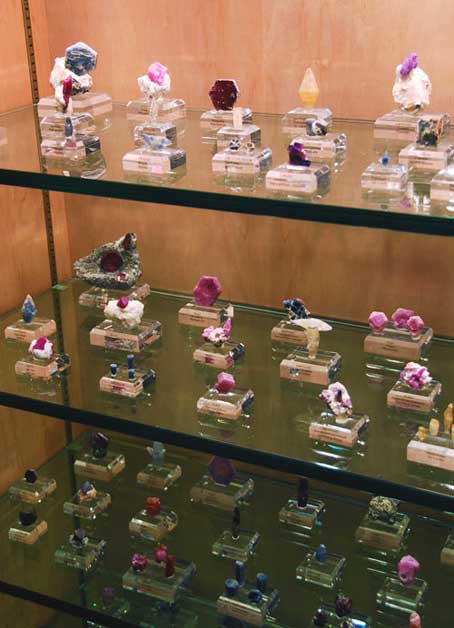 |
| The Corundum Collection is a new installation at Pala, and will be available for purchase once all the specimens are in place. (Photo: Jason Stephenson) |
The collection highlights some of the more well-known deposits of India, Sri Lanka, Myanmar, Vietnam, Madagascar, Tanzania, and some of the lesser-known ones: Russia, Australia, Brazil, Pakistan, Afghanistan, Macedonia, and the U.S., which all produce some form of corundum.
This collection is now on display in the mineral house on the Pala International grounds.
Interested in a single ruby or sapphire crystal? Check the following links to see what’s in stock:
[back to top]
Gems and Gemology News
Scheelite’s Shine
In February, we received a note about a remarkable scheelite mine in Salzburg, Austria. The note came from Dr. Gerhard Niedermayr, Emeritus Curator of Gems and Minerals at the Natural History Museum Vienna (home of the famous “Venus of Willendorf” statuette). According an article by Dr. Niedermayr in the June 2007 Gemmo News, of the Austrian Gemological Society, the crystal material is often found in relation to the useful element tungsten. The Salzburg scheelite deposit is very large and has yielded facetable material like that shown below.
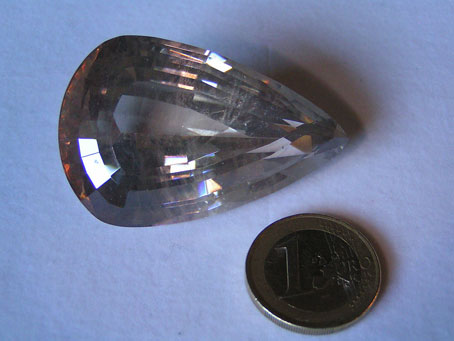 |
| Blast from the past. These recently faceted scheelites were the product of mining operations in 1985. A €1 coin is shown for reference. Above: Teardrop-shaped scheelite gemstone, 5.2 cm., 393.65 ct. Below: Round brilliant-cut scheelite, 32 ct. (Photos: Lene Niedermayr, March 2007) |
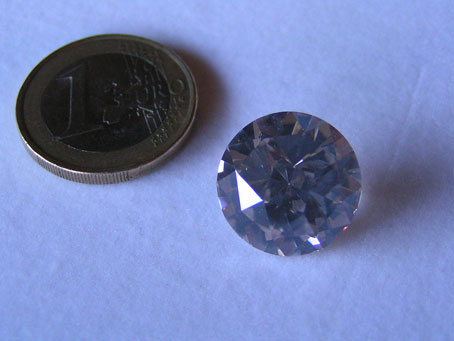 |
Scheelite is relatively soft, but has a high refractive index and dispersion, thereby producing what Dr. Niedermayr calls a “greasy shine.” The largest cut scheelite previously known was 20 carats, according to the article, but several stones 31 carats and above have been more recently produced, including one 5.2-cm., 393.65-ct. teardrop shaped stone, pictured above. When we asked for more background on these stones, here’s what Dr. Niedermayr had to say:
The crystal which yielded these new cut stones actually had been found by a miner [in] 1985 in a 20-x-30-cm. big alpine cleft in amphibolite, in the course of active mining operations. The original 2.6-kg. crystal was broken in many pieces by blasting. From these fragments, more than 20 years later, the gems had been cut. Some other remarkable stones weighed 169 ct., 130 ct., 118 ct., 70 ct., and 39ct. The teardrop shaped stone was by far the biggest one. Material is still available from Andreas Steiner.
We have a few scheelite pieces from China and North America available here. [back to top]
Andesine-Labradorite Testing Underway
On February 1, just prior to the Tucson show, JCK’s Gary Roskin blogged [content removed] regarding relatively inexpensive sales of andesine-labradorite by Jewelry Television (JTV). Sales of the gemstone were so brisk, JTV’s inventory was reduced “to a fraction of its original level,” according to JTV’s own blog entry [content removed] of January 31. The popular stone would be in short supply at Tucson.
 |
| This 34.06-carat sunstone from China was acquired by Pala’s Bill Larson at the time of the ICA Congress in 2005. |
In that same entry, JTV co-founder Jerry Sisk made a cryptic announcement—of a pending announcement: “[W]e are on the cusp of announcing information regarding andesine-labradorite that no one in the gem world has been able to discover!” Roskin openly wondered, “OK—we haven’t been able to discover what? Why it’s selling out at $40-$100/ct? Where it comes from. (China? Tibet? the Congo? Oregon? some lab in Bangkok?) Hmmm. Well I’m curious.”
Over the next days and weeks, the the following were posted to the JTV blog:
- The installment of Jewel Hunter Jack, whose first mission (“accomplished!”) was to track down the location of the andesine mine that “yields dramatic red, green and yellow labradorite” that JTV was selling
- Video clips of Sisk announcing that much of the marketed andesine-labradorite was from mines in northern China and southern Mongolia, and that the color was achieved by heating (the treatment had previously not been detected)
- A link to Andesine Labradorite FAQs, which mention that JTV had forwarded treated and untreated rough, from a source in southern Mongolia, to major labs and universities in the U.S. for research; JTV also offered to buy back what it had sold as “untreated,” until March 30
On March 5, Roskin blogged [content removed] that the JTV rough had been sent for testing to Drs. James Shigley (GIA), George Rossman (Caltech), and John Emmett (Crystal Chemistry). Roskin also speculated on the possibility of diffusion treatment and questioned the claims of “natural color” for material from other non-U.S. localities (Tibet, Congo, Central America).
It will be some time before testing is completed. Meanwhile, read David Federman’s Colored Stone article, “The Furor Over Feldspar” [content removed], which reviews the history of sunstone production in the United States and the perspective of Minnesota gemstone cutter, John Dyer, who actually has worked with andesine-labradorite rough. [back to top]
Industry News
Fundraising for Tanzania Miners’ Flood Relief
Tanzanite (aka zoisite) comes in a variety of hues, some rarer than others—from deep indigo to yellow-green to almost colorless. The material is mined exclusively in Merelani, Arusha, in northeastern Tanzania.
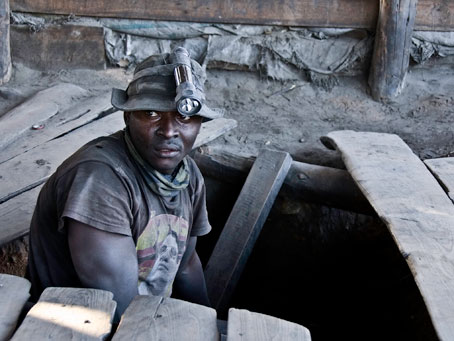 |
| A graphite-coated miner emerges from a tanzanite mine at Merelani’s Block D. Due to the desperate poverty endemic in Tanzania (and so many third-world countries), miners often work under unsafe conditions. The situation is not unique to the mining sector, but cuts across all sectors of the Tanzanian economy. Such conditions are not unlike coal mines in the U.K. and the U.S. in the 19th century. (Photo: Richard W. Hughes) |
Miners Trapped and Killed Following Flash Flood
 |
| Blue tanzanite. This trillion-cut gemstone demonstrates the superb quality unearthed by the miners of Tanzania. From the Pala catalog. (Photo: Wimon Manorotkul) |
In late March, as many as 70 miners at a tanzanite mine in Merelani were trapped and killed following seven days of heavy rain, according to a statement by the charitable organization Oxfam Ireland. The statement says that a two-hour flash flood on March 29 “swept off the surrounding hills and through several villages in the Mirerani sub-district” and that hundreds of houses and latrines in nearby villages have been destroyed.
Tanzanite Foundation and AGTA Relief Fund
Last Monday, a press release from the American Gem Trade Association announced a joint Flood Relief Fund in partnership with the Tanzanite Foundation. According to the release:
Funds will be distributed in various ways focusing on immediate relief and assistance to the families that have been unfortunately affected, as well as future projects. Furthermore, strategies and infrastructure encompassing safety measures will be implemented in order to attempt to prevent such a tragedy from occurring again.
The Tanzanite Foundation sincerely thanks you in advance for your generosity. Please note that all donations are tax deductible and will be acknowledged with an invoice. 100% of all monies donated will be used for this worthy cause. Checks can be made out to AGTA-Tanzanite Fund and sent to the Tanzanite Foundation:
42 W 48th Street,
Suite 1702,
New York, NY 10036.OR
Deposited directly:
Bank Of America
Attention: Troy Zupancic
15303 Dallas Parkway
Suite 290
Addison, TX 75001
1-888-852-5000Account Number: 004881834475
Swift: BOA US 3N
Routing : 026 009 593For further information please contact Hayley Henning at the Tanzanite Foundation 212-575-3020 or hayley@tanzanitefoundation.org.
While dramatic incidents like the present one in Merelani fortunately are not common in countries of the global south, the life of a miner is not easy. (Even in the U.S., coal mining continues to be one of a dozen relatively hazardous occupations.) Mining safety usually is balanced against other issues, such as attraction of foreign investment and a real need of workers for employment.
Entrepreneurs are capable, however, of a measured and humane approach to mining development, as demonstrated by mining operator Moussa Konate in Mozambique (see our February Gem News report), who appears to be placing sustainability before swift gain: he is focusing on community infrastructure as well as mechanization.
Thus the good, the bad, and the ugly are woven into the backdrop behind the beautiful and exciting minerals and gemstones that take center stage.
For more on the story of the Merelani mines, see our reprint from Peter Bancroft’s Gem and Crystal Treasures. [back to top]
Burma Bits
2007 Gem Trade Statistics – 89% Increase Over FY2006–07
A February 20 item on the Yangon City website stated that “the export of gems and low-prize gems fetched over US $562 million from January to December, 2007, it was learnt.” The item announced the 45th Gems Emporium, which was held in March.
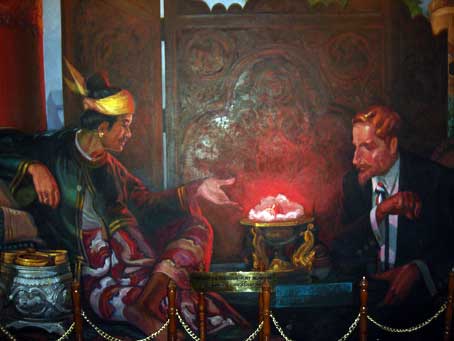 |
| “Awed by the Fabulous Ruby Ngamauk.” Read the story of this ruby in our reprint of C. M. Enriquez’s “Fire-Hearted Pebbles from Burma.” Below, Han Htun, FGA, and Pala’s Bill Larson, under the image of King Tibaw showing the royal ruby to gem merchant extraordinaire and author Edwin Streeter. (Photos: Bill Larson) |
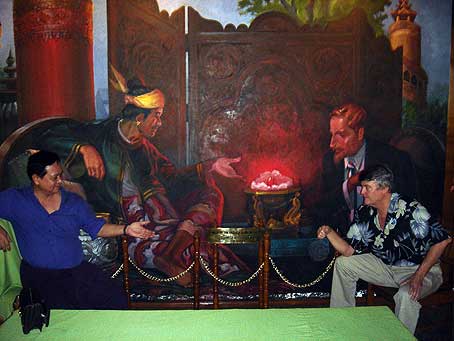 |
The $562 million figure is consistent with the three $185 million dollar sales ($555 million total) reported or estimated for 2007. An April 8 Bangkok Post article echoed this report. This figure doesn’t seem to account for several interim sales held in December, August, and January, however.
The 2007 calendar year total can be compared roughly with the fiscal year 4/06–3/07 total of $296.9 million—an increase of 89 percent.
As always, see our Burma Gem Sales and Statistics page for updates. [back to top]
March Gem Emporium Sales Figures Withheld
No sales figures have been issued for the 45th Annual Myama Gems Emporium, held March 9–20. An Agence France-Presse (AFP) article March 11, reported that $153 million (€100 million) worth of jade, gems, and pearls would be offered at the sale. This is considerably less than the €148 million worth offered at last year’s annual sale, although the lots offered are 7,700, compared with 6,000 a year ago.
Pala has received personal communication Chinese buyers at the jadeite auctions account for more than 95% of the sales. No buyers from the U.S.A. were listed.
AFP quoted an official as stating that the 7,123 jade lots offered this year were worth about €78 million. The official said this number of lots “is the largest quantity of jade compared to previous auctions.” A March 11 Rapaport story, attributed to Xinhua News Agency, echoed the jade lot figure as well as an offer of 300 lots of gems and 270 lots of pearls.
India-based Sify reported that the highest floor price was for a 30-kg. boulder worth €2.38 million. Sify posted an AP photo of a 142-kg., $2.2-million boulder, along with three other photos from the sale. [back to top]
Bite-Sized Bits
- Brunei to promote trade with Burma in gems, jade, and jewelry (Xinhua)
- Japanese partner delivers 40,000 South Sea pearls to Burma operation (Myanmar Times) [back to top]
— End April Newsletter • Published 4/20/08 —
March 2008 Newsletter
Shows and Conferences
Pala International News
Gem and Gemology News
Industry News
- Burma Bits
- Sales Up for Semi-Precious Stones
- 45th Myanma Gems Emporium Underway
- Who’s Buying?
- Trade Figures – 4/2007–8/2007
Art and Books
Shows and Conferences
Hot Colors in Tucson
In case you couldn’t make it to Tucson this year, Pala’s Jason Stephenson provides the following highlights.
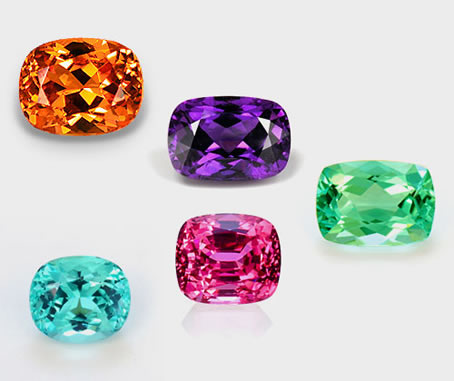 |
There weren’t necessarily any new varieties on display this year at Tucson, but there were definitely some new localities producing some of our old favorites.
Tanzania has been a real hot spot for new gem deposits lately. The aftermath of the giant spinel crystal was scattered amongst a handful of dealers. These shocking neon spinels with mixtures of red, pink, and orange were unquestionably distinguishable from other localities by their unique hues. Some larger stones—8-ct.-plus—were available, but seem to have either some silk when pure color, or clean with a bit of brown. See our new Tanzanian spinels here.
There was another new find in Loliando, Tanzania, of spessartite, which was recently dug between December ’07 and January ’08. Beautiful mandarin and pumpkin colors reminiscent of the Nigerian deposit. The larger stones unfortunately had some clarity issues but the smaller ones were bright and colorful. Along with cut gems there were some incredible crystals from marble size to baseball size. We have dozens of these gemstones available here.
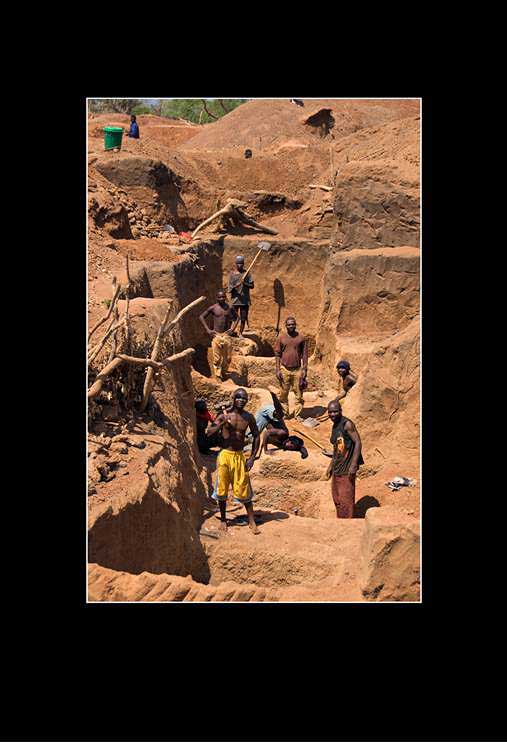 |
| Step Right Down. Miners in Mozambique dig through several meters of hard soil in a series of benches to reach the alluvial tourmaline-bearing horizon. This photo, by Gems & Gemology editor Brendan Laurs, is currently on display as part of a new exhibit, “On the Gem Trail,” which features 35 images of gems, landscapes, and cultures from Mozambique and Colombia. More info and photos available here. (Photo: Laurs/GIA) |
There was still plenty of buzz around the new paraiba-type tourmaline from Mozambique, as everyone learns more about the array of colors being produced from this locality. Some of the interest this year involved the rich purple and magenta colors that are the natural counterparts to the iconic paraiba blues. The electric greens and bluish greens round out the color palette. Conversation about these neon tourmalines always entails the Brazilian material, which seems to be almost unobtainable. So for now our path to paraiba continues to wind through Mozambique. See our selection of neon tourmalines here. [back to top]
Pala International News
Pala’s Featured Stones: Ruby and Sapphire Suites, Cat’s Eye Emerald
This month we go back to the classics: ruby, sapphire, and an emerald with a twist.
Ruby and Sapphire Suites
Two beautiful sets of corundum, red for girls and blue for…well, probably girls, too.
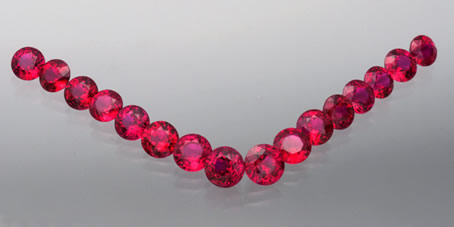 |
| Ruby suite. Sixteen gorgeous, pure and vivid red, round brilliant-cut rubies with a total weight of 16.43 cts. Dimensions range from 5.5 to 6.4 mm. Search on inventory number 13895. (Photo: Wimon Manorotkul) |
The limited market on fine quality ruby and sapphire seems to be shrinking as prices keep climbing. Finding a nice matched pair can even be difficult, since most of the time only one stone can be cut from a single piece of rough (because corundum crystals don’t grow very large). Then the process of matching stones by hue, tone, saturation, size, and cut can be a tedious and time consuming task.
So take in the sight of these beautiful suites, which have been accumulated through time and with attention to detail.
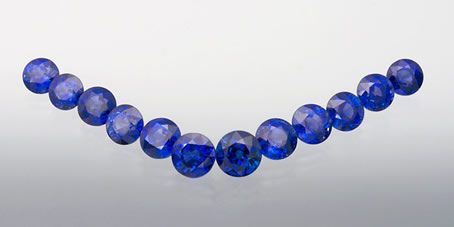 |
| Blue sapphire suite. Twelve beautiful royal blue, round brilliant-cut sapphires with a total weight of 24.85 cts. Dimensions range from 6.3 to 7 mm. Search on inventory number 13894. (Photo: Wimon Manorotkul) |
Cat’s Eye Emerald
The color of chrysoprase, the preciousness of an emerald, and the phenomenon of a cat’s eye. This stunning gem will fool even the sharpest of collectors with its individuality. This unique emerald will certainly be:
A cool colored cat’s eye in a colloquialism amongst collectors.
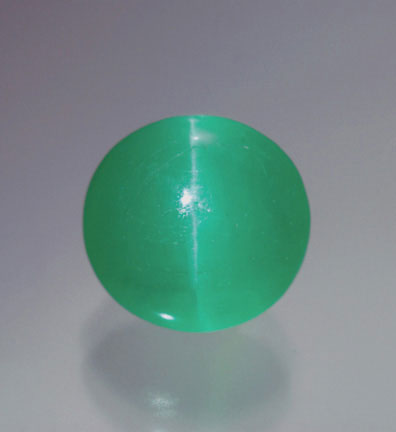 |
| Cat’s eye emerald from Brazil, 4.62 cts., 10.50 x 9.92 x 6.37 mm. This stone has been sold. (Photo: Wimon Manorotkul) |
Interested? Select the inventory numbers above, call, or email us. [back to top]
Gems and Gemology News
 |
Passing of GAA’s Grahame Brown
The Gemmological Association of Australia’s Dr. Grahame Brown died on January 15 in Brisbane after a struggle with cancer, according to the GAA website. Brown was the longtime editor of the GAA journal, The Australian Gemmologist.
We asked Richard Hughes for his thoughts about the life and death of Grahame Brown.
Grahame Brown was one of our field’s most prolific writers. But more than that, he had an insatiable curiosity that manifested itself in everything he did.
I first learned that Grahame was ill when I was in Tanzania in October. He sent an e-mail seeking information on a gemological subject and mentioned that he had been fighting a battle with cancer.
This was not a good day. Just minutes before reading his message I learned that my hometown had been evacuated and was frantic as I could not reach my wife.
Events such as these tend to focus the mind, driving home the clear distinctions between the meaningless and the meaningful. This was clearly something that Grahame understood.
Having the pleasure of knowing Grahame Brown meant a lot to me. I learned so much from him. But never more than in the end. His actions taught me the importance of work, which is what remains when the flesh is gone. His work is our link to his spirit and his immortality.
Grahame, 71 years old, was the author of more than 500 gemological papers, according to an obituary at JCK Online. [back to top]
The Stars Were Out In Color
High fashion and fine gems studded the red carpet at this year’s Academy Awards on February 24. Penelope Cruz was wearing a spectacular pair of ruby and diamond earrings from Chopard with a total carat weight in ruby of 25 carats.
 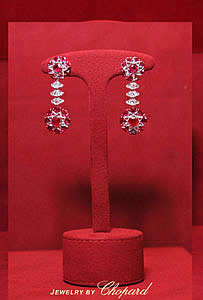 |
| Penelope Cruz wears ruby and diamond earrings from Chopard, with rubies totaling 25 carats. (Photos: Chopard) |
Sir Elton John was definitely bejeweled with his diamond lariat necklace and a 120-ct. pear-shaped pink tourmaline ring. Caroline Gruosi-Scheufele, co-president of Chopard (pictured to the right of John) wore a floral necklace and earring set featuring 55 carats of amethyst, 96 carats of rubies, and 24 carats of black diamonds. [back to top]
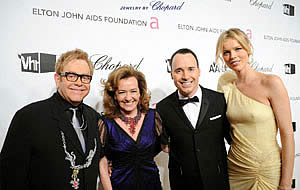 |
| Sir Elton John, at his annual AIDS Foundation viewing party, with (l–r) Caroline Gruosi-Scheufele, David Furnish, and Eva Herzigova (Photo: Courtesy of Wire Image via Chopard) |
Fingerprinting the Hope Diamond
Phosphorescence of Blue Diamond Studied
An inexpensive, portable spectrometer taken “into the vault” has allowed for the spectral fingerprinting of 67 natural blue diamonds, including the two largest known: the Hope and Blue Heart. The Hope Diamond has long been known to glow red when exposed to ultraviolet (UV) light, a phenomenon thought to be quite rare; greenish-blue phosphorescence is more common.
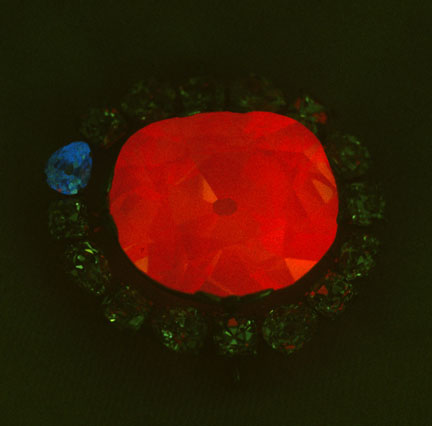 |
| Hope Diamond glows for 8.2 seconds after exposure to UV light. The intensity, color, and duration are unique to each blue diamond. (Photo: John Hatleberg, courtesy National Museum of Natural History) |
Researchers, including Jeffrey Post, curator of the Smithsonian’s National Gem and Mineral Collection, and Sally Eaton-Magaña, now technical editor of Gems & Gemology, found that “virtually all” blue diamonds phosphoresce orange-red (660 nm.). But this band usually is obscured by an accompanying green-blue (500 nm.) emission. It’s the intensities of these two bands—unique to each stone and likely due to relative amounts of boron and nitrogen—that provide gemologists with the means of fingerprinting.
The findings were first presented at the Gemological Research Conference of the Gemological Institute of America. According to the abstract [PDF, 5.7 MB] of that presentation, the method employed—phosphorescence spectroscopy—is not often used in gemology, but it allowed them to test the stones at room temperature without fear of damaging the jewels, which happened to be on loan for exhibition at the Smithsonian.
The research was published in January by the Geological Society of America. Also tested were treated and synthetic blue diamonds, which “showed behavior distinct from natural stones,” according to the article’s abstract.
See also:
- Smithsonian Magazine article (1/14/08)
- Science News article (1/12/08)
- American Geological Institute article (1/11/08)
- Discovery Channel article (1/8/08) [back to top]
Ornament as Art: Avant-Garde Jewelry from the Helen Williams Drutt Collection
Once you’ve seen the Hope Diamond and the Carmen Lúcia Ruby at the Smithsonian’s National Museum of Natural History, you’ll want to head over to the American Art Museum’s Renwick Gallery. In “Ornament as Art” you’ll be hard-pressed to find actual gemstones or crystals, but the variety of 275 examples of “wearable art” could be worth the search.
Drutt’s collection was assembled over 40 years. The current show, which closes July 6, highlights the work of more than 115 artists from 21 countries. [back to top]
Industry News
Burma Bits
Sales Up for Semi-Precious Stones
An informal survey of Yangon jewelers found sales up from a year ago, according to The Myanmar Times’ 2/25–3/2/08 issue. Jewelers who were forthcoming said at least half their sales are for semi-precious stones, with spinlel, amethyst, peridot, topaz, and citrine being the most popular. Credit was given to fashion shows that showcased semi-precious jewelry. [back to top]
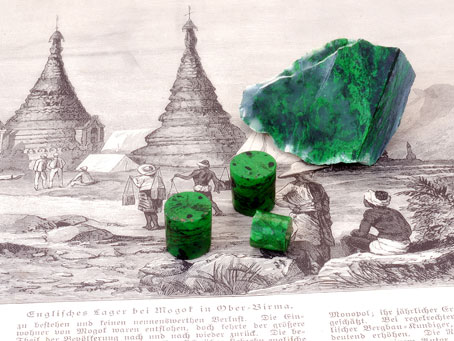 |
| Maw-sit-sit from Burma. Read more about this rare material. (Photo: Wimon Manorotkul) |
45th Myanma Gems Emporium Underway
The 45th Myanma Gems Emporium, which was scheduled for March 9–20, is now underway, according to a Global Insight article. The story stated that $153 million in gems would be offered at the sale. [back to top]
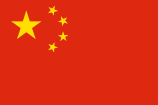 |
Who’s Buying?
The Christian Science Monitor last week examined the fact that Burma gem sales continue to be lucrative due, in large part, to China’s patronage. The article quotes one of Thailand’s prominent intellectuals, Acharn Sulak Sivaraksa: “Burma is supported by China. End of story.”
As we reported in December, the (legitimate) gem trade in Burma is dwarfed by oil and timber. The article puts the trade with China, Thailand, and India in electricity, natural gas, oil, and timber at $2 billion a year, compared with the reported $297 million in fiscal year 2006–07.
Sulak goes so far as to characterize China’s investment in Burma (which includes weaponry) as “imperialist.” [back to top]
Trade Figures – 4/2007–8/2007
The following statistics were included in a February 10 story by the official China Xinhua News Agency.
- Jade Production: 9,505 tons
- Gem Production: 9.433 million carats
- Pearl Production: 35,369 mommis (132 kilograms)
We’ve updated our Burma Gem Sales and Statistics accordingly, on Palagems.com. [back to top]
Art and Books
Gem Paintings of Ilya Schar
Last month in Pala’s Mineral News, we profiled the photography of Bruno Cupillard, who creates works of art from painstaking shots of mineral specimens and gemstone inclusions. (Cupillard kicked off FotogFocus, our occasional series devoted to the work of gemstone and mineral photographers.) Another artist, Ilya Schar, uses gemstones as his medium, but in a different way: literally painting with the stones themselves.
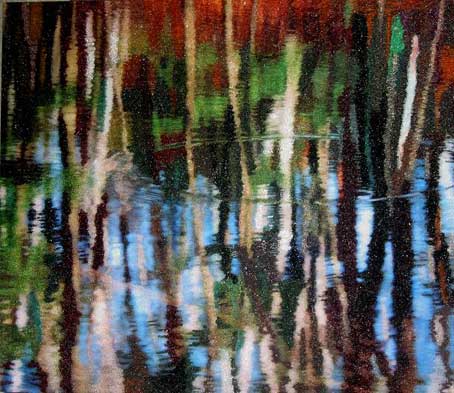 |
| Reflection, 2006, 30"x26". This work was created with peridot, emerald, opal, topaz, tourmaline, spalerite, citrine, rhodonite, carnelian, azurite, obsidian, and more. (Photo courtesy Ilya Schar) |
A native of Moscow, Schar now lives in Beverly Hills and devotes himself to his lifelong love of art and gemstones, following a career as an oral surgeon. According to his representative, Marina Deutschman, Shar crushes and polishes the stones by hand, and no paint at all is used in his work.
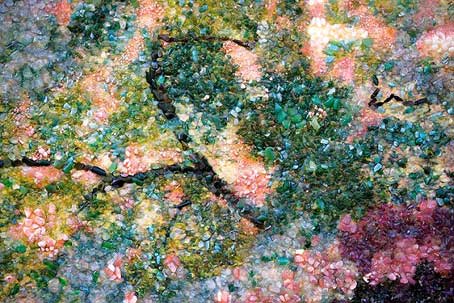 |
| Smoke Trees (detail), 1999, 24"x24". This work was created with red tourmaline, emerald, topaz, citrine, black tourmaline, agate, tiger eye, garnet, lapidolite, hematite, and more. See the complete work here. (Photo courtesy Ilya Schar) |
Schar has shown at venues ranging from the Armory Show in New York, the Gemological Institute of America Museum, New York’s Broadway Gallery, and the Pacific Design Center. The full range of Schar’s work can be seen at the artist’s website. [back to top]
American Mineral Treasures
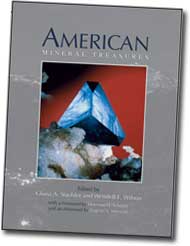 |
The theme of the 54th Annual Tucson Gem and Mineral Show was “Minerals of the USA,” highlighting all the great mining localities that brought beautiful and fascinating specimens for the world to see. American Mineral Treasures, edited by Gloria A. Staebler and Wendell E. Wilson, was inspired by this year’s show.
This hardbound 350-page beauty is the most comprehensive book compiled on American minerals, mining localities, and the great folklore that goes along with discovery and exploration.
The introduction, on a brief history of mineral collecting, sets the stage and outlines collectors, starting in the early 1600s and continuing through today’s prominent collectors/dealers.
The chapters bounce around the country like an enthusiastic collector seeking knowledge about the variety of deposits—from the remote epidote deposits in Alaska to the unusual zinc ore minerals of New Jersey, from the spectacular pegmatite minerals of San Diego County to the high-elevation aquamarine and rhodocrosite deposits of Colorado. From the shocking pyromorphite specimens of Idaho to the stunning crystallized gold from the foothills of the Sierra Nevadas. A total of 44 mineral-producing areas are highlighted in glorious detail.
All the chapters were written by the individuals actually involved with the mining efforts, which gives the stories a real, raw sense of what it was like. Each chapter takes you through the history of the mining area and all the charters driven by “gold fever” to find what lay behind the rock wall.
These colorful stories of adventure and exploration are complemented by splendid photographs of some of the best and/or quintessential pieces found. A must-have encyclopedia of USA minerals for the collector.
The book is available from The Mineralogical Record. [back to top]
— End March Newsletter • Published 3/19/08 —
February 2008 Newsletter
Shows and Conferences
Pala International News
Gem and Gemology News
Industry News
- Irradiated Topaz: Something old, something new, something borrowed, something blue
- Burma Bits
- Jade and Gem Sales News
- Gem Dealers React to Mandalay–Rangoon Market Move
- Bits & Pieces: The Geology of…Ruby; Russia to Prospect for Gold in Kachin State
Shows and Conferences
First International Pearl Convention: GIA Report
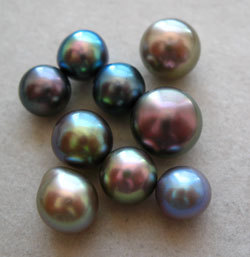 |
| These 8+ mm. cultured pearls were harvested from Mexico’s Sea of Cortez. Pearl production was one topic addressed at the conference. (Photo: Douglas McLaurin, courtesy Perlas del Mar de Cortez®) |
Last November, we called your attention to a pearl convention to be held that month in the United Arab Emirates. According to the First International Pearl Convention website, 120 delegates from over 30 pearling nations attended the conference, which was held in Abu Dhabi. The five-day convention included “ten technical seminars, a daylong summit, two study tours, and a host of networking opportunities.” The inspiration behind the event was a revitalization of what was once a thriving local trade until the early 20th century, according to officials who opened the convention.
The Gemological Institute of America’s Gems & Gemology Spring 2008 issue contains a report on the convention. It includes commentary on the conference highlights—technical issues, production, and economics and marketing. For instance:
- Elisabeth Strack, from Hamburg, Germany, “discussed terminology and taxonomy issues (e.g., the vast majority of pearl ‘oysters’ are actually not classified biologically as oysters)”
- Climate change also figured into the discussion: Shigeru Akamatsu, from Tokyo, mentioned the challenge of over-warm water temperatures on the small akoya pearl oysters. (In his GemmoBasel 2005 session, Kobe-based Andy Müller stated, “Temperatures in excess of 32°C [89.6°F] are usually deadly”) [back to top]
Pala International News
Pala’s Featured Stone: Haüyne
Haüyne. Huh? The origin of the name stems from the French pioneer in crystallography. René Just Haüy lived from 1743–1822 and is considered one of the founders of modern mineralogy. Haüyne is a member of the sodalite family, which also includes lazurite, hackmanite, and sodalite.
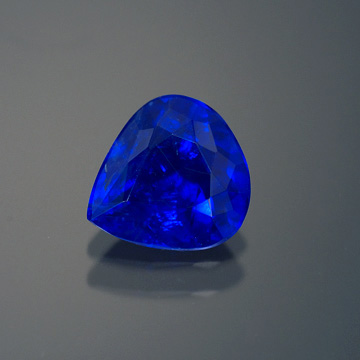 |
| Pear-shaped haüyne, 1.73 cts. This stone has been sold. (Photo: Wimon Manorotkul) |
These vivid neon blue haüynes were mined in Germany by some local collectors within the last couple of years. They are from a small quarry in the Mendig lava flow in Niedermendig, in the Eifel Mountains. The color is reminiscent of a blue sapphire or a dark paraiba tourmaline. Also available is a 1.03-ct. oval (This stone has been sold.).
Most facetable stones are under 0.2 cts., so the size of these pieces is exceptional. [back to top]
Bill Larson Elected to AGTA Board of Directors
 |
Pala International President Bill Larson was elected to the Board of Directors of the American Gem Trade Association (AGTA), it was announced January 16. The term of office is three years.
Gems and Gemology News
GAAJ and GIT: Treatment of Blue Sapphire
”Super Diffusion Tanusorn” – Lead Glass with Cobalt
The Gemmological Association of All Japan Research Lab (GAAJ) has released a report on a technique of lead-glass filling, “coloured blue by mixing cobalt metal,” being used to treat pale-colored blue sapphire. The report, updated December 27, 2007, includes photographs and a radiograph, as well as diagrams of spectral and chemical composition analysis.
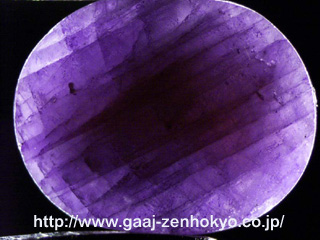 |
| Treated sapphire displays fractures, cracks, and twinning planes. (Photo courtesy GAAJ Research Lab) |
The GAAJ article references a corroborating report from October 2007 by The Gem and Jewelry Institute of Thailand Gem Testing Lab (GIT) entitled “New Blue Treated Sapphire.” The latter report concludes that the original sapphire material was “semi-translucent [and] pale colored” and contained numerous cracks. The material was heated at high temperature in a process “involving cobalt and lead containing flux.” The resultant color was achieved by the “cobalt-bearing solid residues” that remained in the healed fractures after treatment.
According to the GAAJ report, the filling method “Tanusorn” is named after “a person who developed this treatment.” The GIT report acknowledges “Mr. Tanusorn Lethaisong” for providing samples allowing disclosure of the technique. [back to top]
Path to Paraiba: More on Mozambique’s Tourmaline Mines
A year ago, we profiled Moussa “Moses” Konate and his paraiba-type tourmaline mines, in “The Path to Paraiba Winds Through Mozambique.” This month, the GIA released a report on the deposits following a visit late last summer. Gems & Gemology editor Brendan Laurs and Netherlands National Museum of Natural History researcher J. C. “Hanco” Zwaan. The report discusses the location, geology, and mining of copper-bearing tourmaline.
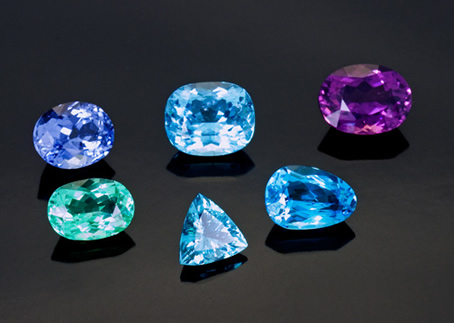 |
| So many choices… The group of paraiba-type tourmalines above demonstrate the range of color being produced by the mines near Nampula, Mozambique. (Photo: Wimon Manorotkul) |
As we reported last March, Konate had suspended operations in order to develop the local community infrastructure. The GIA report states that Konate and crew “had completed a comprehensive environmental impact report and performed systematic mapping and test pitting of their claim” in preparation for mechanization of the operation. They foresee completion of a 150–200-ton-per-day washing plant by mid-2008.
 |
| New in stock. This 76.91-ct. cushion cut neon tourmaline from Mozambique was just added to our inventory. See inventory #16167. (Photo: Wimon Manorotkul) |
[back to top]
Industry News
Irradiated Topaz: Something old, something new, something borrowed, something blue
 |
| Virtually colorless topaz rough (above) is irradiated and then heated to turn blue (middle layer of rough). Photo by Robert Weldon, © 2007 Gemological Institute of America. |
These two items on the subject of irradiated topaz came across our desk over the last couple of months. Everyone seems to be upbeat about this year’s prospects.
- Blue Topaz: Now Street Legal by Modern Jeweler Editor-In-Chief Cheryl Kremkow, explains that the three companies licensed by the Nuclear Regulatory Commission for distribution of irradiated gems are affiliated with major blue topaz producers, thus facilitating a rapid flow of such stones into the market. That market is estimated at 24–60 million carats in the U.S. Prices have increased, but of course the stones were inexpensive to begin with…
- Irradiated Blue Topaz: Now What? by Colored Stone Associate Editor Karla A. Rosenbusch, begins with a prediction: “Blue topaz is going to once again become a cornerstone of the colored stone business.” Given the imprimatur of Nuclear Regulatory Commission licensees, blue topaz can be distributed with safety concerns allayed, according to the article.
And Palagems.com is pleased to host a reprint of Robert Weldon’s Topaz Blue & Déjà Vu. First released late last summer by the Gemological Institute of America, it contains a clear and crisp discussion of the history and science of gemstone irradiation, up to the point of recent Nuclear Regulatory Commission actions. Beautifully illustrated with Weldon’s own photographs. [back to top]
Burma Bits
Jade and Gem Sales News
» First Sale of Year Held January 15–19
The 24th Gems & Jade Sales 2008 was held January 15–19 by Union of Myanmar Economic Holdings Ltd. (UMEHL), resulting in the sale of the following, according to the official New Light of Myanmar newspaper (Jan. 19 and Jan. 20).
- 357 jade lots sold out of 1,214 offered
- 247 gem lots sold out of 397 offered
No monetary figures were disclosed, as was the case with UMEHL’s 23rd sale in August 2007, which sold 404 jade lots of 1,121 offered and an unknown number from 315 gem lots offered. (See also the UMEHL website.)
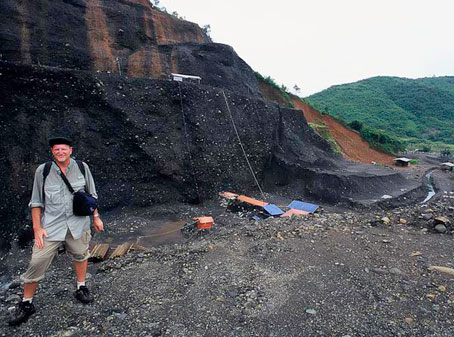 |
| Can you pronounce “Hpakan”? Richard Hughes at Burma’s jade mines in Upper Burma, September 2004. (Photo © Richard W. Hughes) |
» 45th Gems Emporium Scheduled for March 9–20, 2008
On February 9, Minister for Mines Brig-Gen Ohn Myint met with organizers of the 45th Myanma Gems Emporium 2008, according to the official New Light of Myanmar. The dates for the sale were announced as March 9 to 20. The March 2007 sale totaled $185 million. [back to top]
Gem Dealers React to Mandalay–Rangoon Market Move
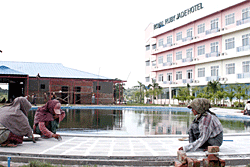 |
| Construction workers lay tile around a hotel swimming pool last fall near jade warehouses in Mayangone township. (Photo: Myanmar Times) |
Mandalay gem traders have expressed concern to The Irrawaddy regarding relocation of the largest gem market, from Mandalay to Rangoon (Yangon). The January 21 story quotes dealer Than Tin: “The authorities want to move the Mandalay gem market to Rangoon because it would be easier to control and export large quantities of gems legally. … Everyone is disappointed.” The Irrawaddy claimed that the Mandalay gem and jade market “has slowed drastically” in light of the impending relocation.
We reported on this move in November via a Myanmar Times story. At that time, Yangon’s Mayor, Brig-Gen Aung Thein Linn, said that warehouses were being built in the northern Mayangone township “as part of a plan to make the city Myanmar’s sole gem and jade trading centre.” Also planned were a new hotel and six dozen buildings to “be used as jewellery shops and as accommodation for jade industry specialists visiting Yangon”—the hope being that foreign carvers would aid in the development of the value-added jade market that the government is eager to exploit. [back to top]
Bits & Pieces
» The Geology of…Ruby
We stumbled across this item from 2004 that still might be of interest due to its mention of Mogok ruby.
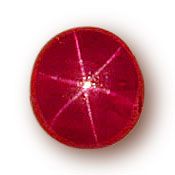 |
| This 4.86-ct. star ruby from Mogok is found in our Ruby Buying Guide. (Photo: John McLean) |
The Geology of…Rubies by Anne Sasso: Discover (Nov. 2004)
This is an overview of the theories and controversies of ruby formation. A delicate balance is required to produce ruby: a rare avoidance of iron and silica, together with a trace of chromium. Penn State professor Peter Heaney calls it a “minor geological miracle.”
The article closes with a statement that deserves comment. “Politics in Myanmar have long blocked scientists—especially Western scientists—from entering the country to take a look.” We mentioned this to ruby expert Richard W. Hughes, who had this reply: “The Burmese regard their gem resources as a strategic resource. They no more invite ‘Western scientists’ to poke around than we invite Saddam’s people to Las Alamos.” Think the Burmese are paranoid? Just ask the Bolivians, to whom it was revealed this month that Peace Corps volunteers and a Fulbright Scholar were asked by a U.S. Embassy official to spy on any Cubans or Venezuelans with whom they came into contact during their stay, as reported by ABC News among others.
For more on ruby in Burma, see this chapter from Richard W. Hughes’s classic, Ruby & Sapphire. [back to top]
» Russia to Prospect for Gold in Kachin State
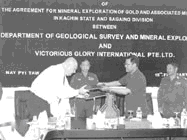 |
| Victorious Glory chairman Krivoshey Pavel receives copy of mining agreement on Feb. 15. (Photo: New Light of Myanmar) |
Last Saturday, the official New Light of Myanmar reported a deal struck with Russian Federation-linked Victorious Glory International for “exploration of gold and associated minerals along Uru River between Phakant of Kachin State and Homalin of Sagaing Division.” This new development began with a ban on gold mining imposed by the military last August. Singapore-registered Chandwin Projects holds an 80 percent interest in Victorious Glory, according to The Moscow Times. Such international cooperation continues a trend that includes a 25-year interest-free loan from Saudi Arabia and a 33-percent jump in trade with Japan. Last March, The Kachin Post reported on a joint venture with Victorious Glory to explore for uranium in a jade mine in Hpa Kant Township. [back to top]
— End February Newsletter • Published 2/21/08 —
Other February News
 |
February 8: GIA Reprint – Topaz Blue & Déjà Vu
An article by Robert Weldon
We’re pleased to reprint Robert Weldon’s article, “Topaz Blue & Déjà Vu,” courtesy of the Gemological Institute of America. Weldon neatly discusses the history and science of gemstone irradiation, up to the point of recent Nuclear Regulatory Comission actions.
At right: Virtually colorless topaz rough (above) is irradiated and then heated to turn blue (middle layer of rough). The NRC and experts today say that topaz should be faceted before it is irradiated so that cutters are not exposed to potentially harmful dust. Rough in the range of 25 to 50 ct, faceted gems in the range of 32.72 ct to 7.12 ct. Photo by Robert Weldon, © 2007 Gemological Institute of America.
January 2008 Newsletter
Shows and Conferences
Pala International News
Gem and Gemology News
- Pala District Pegmatite Opens Wider
- AGTA: More on Glass-Filled Rubies
- Jade from Qinghai Used in Olympic Medals
Industry News
- Radiation Safety Consultant Addresses Blue Topaz
- Burma Bits
- Burma Announces 2008 Sales
- Playing with Numbers: A Look at the November Sale Figures
- Burma Trade with China Up 37% Over Last Year
- Miners’ Lives and Livings
Shows and Conferences
Tucson Time – February 6–17, 2008
 |
Make your plans for the world’s greatest gem and mineral show in February.
See Pala International’s page on the Westward Look Show site.
Pala International will be represented in Tucson as follows.
Event: AGTA GemFair
When: February 6–11, 2008
Where: Tucson Convention Center
Booth: 1016–1018
Event: Westward Look Mineral Show
When: February 8–11, 2008
Where: Westward Look Resort
Suite: 236
Website: Official show website
Event: 54th Annual Tucson Gem and Mineral Show
When: February 14–17, 2008
Where: Tucson Convention Center
Booth: Aisle 5 East
We look forward to seeing our many friends there. Visit the Pala International Show Schedule for future events. [back to top]
Jade Art Now – February 10–15, 2008
Friends of Jade Sponsors Tucson Exhibition
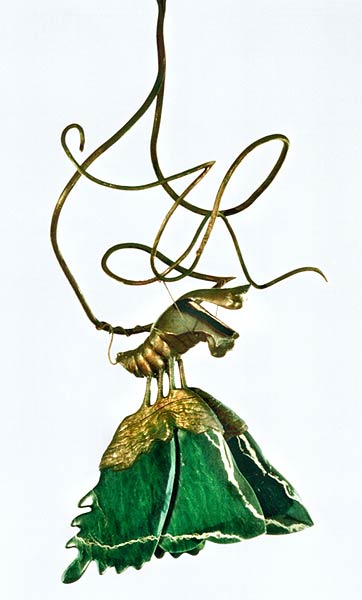 |
| Awakening by Deborah Wilson. Jade, bronze, and steel. (Photo courtesy Deborah Wilson) |
Friends of Jade presents its second annual exhibition of contemporary jade sculpture and jewelry, concurrent with the other major Tucson shows next month.
Event: Jade Art Now
When: February 10–15, 2008
Where: Antiquities, Plus... Gallery
Address: 2752 N. Campbell Ave., Tucson
[back to top]
Pala International News
Pala’s Featured Stone: Multi-Colored Tourmaline
Mozambique Surprise
This month’s featured stone comes from the land made famous for the recent discovery of paraiba tourmalines. Along with the rare occurrence of the element copper, we also find a mix of elements creating a wide variety of colors in the tourmaline family. The multi-colored tourmaline exhibits the unusual nature of tourmaline deposits in Mozambique.
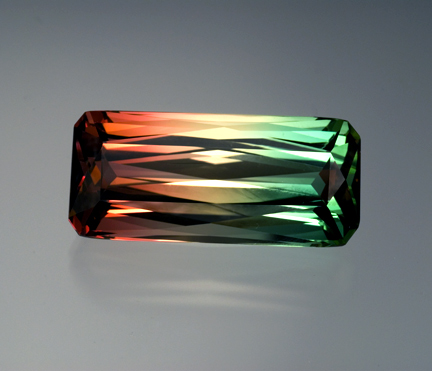 |
| Multi-colored tourmaline, 59.40 cts., 36 x 15.23 x 12.57 mm. Search on inventory number 16129. (Photo: Wimon Manorotkul) |
You can imagine the original crystal growing through a metamorphosis of color: first encapsulating all the iron in the green section of the crystal, then introducing a mixture of manganese and titanium to produce the yellow band, and then finally exhausting all the iron and crystallizing the newly introduced manganese chromophore into the tourmaline lattice, which produces the final pinkish-red section. (Don’t quote us on this; our description is a simplification of a complex process that occurs in the genesis of multi-color tourmaline.)
This complex and varying composition must crystallize in unique conditions. The fact that the entire tourmaline emerged flawless after cutting is a true feat of Mother Nature.
Interested? Select the inventory number above, call, or email us—or see this gemstone in person at the Tucson Show. [back to top]
Gems and Gemology News
Pala District Pegmatite Opens Wider
Oceanview Mine Strikes It Big
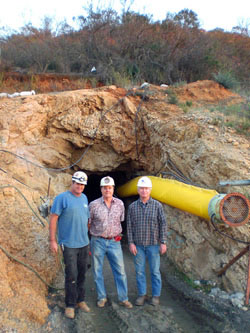 |
| Jeff Swanger, Bill Larson, and John McLean preparing to go underground. (Photo: Jason Stephenson) |
The new year brings new gems to the surface. The Pala Mining District pegmatite opens wider. (See more on this recent find in last month’s Mineral News.)
With the 49er pocket continuing to show its girth, members of the Pala crew—including Bill Larson, John McLean, and Jason Stephenson—were invited up to the Oceanview Mine on December 14, 2007, to see the progression first-hand and get their hands dirty. Owner Jeff Swanger, being a true miner and rock hunter, knew we wanted to get a taste of excavating some of the lustrous beryls that have been bubbling out of the pocket. Jeff set us up with hard hats, lights, a pneumatic chisel, crowbars, screw drivers, and kabob sticks for exposing the delicate crystal clusters.
Jeff and his crew have been excavating the 49er pocket since its discovery on September 22 of 2007—moving rock and cleaning hundreds of specimens from large euhedral feldspar crystals, gigantic quartz clusters, schorl crystals, and beryl specimens. Peter Renwick was there this time making runs in and out of the mine with the bobcat, transporting the clay-laden specimens to their cleaning baths.
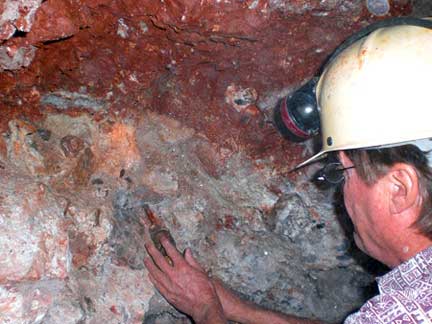 |
| Bill Larson in action. A legend in the gem mining community, back to his roots. (Photo: Jason Stephenson) |
The new face of the 49er pocket had been recently cleaned up with a few precise explosions to expose the mineral-rich area that encircled a solid clevelandite plate. Most of the pristine specimens had been drawn from around this section, and a dozen beryl faces were already shining and waiting to be plucked from their host (pictured above). Bill immediately went to work with the mini-jack and crowbar, carefully removing rock sections that would relieve pressure on the small sections that had potential to yield the finest matrix specimens.
Like a sculptor freeing the figure from within solid stone, the Pala crew wrestled with the stubborn rock and luckily removed all the major pieces without any damage. Extracting the largest chunks possible was the technique, since they could always be trimmed down later. Three hours later we had removed several buckets full of promising looking specimens; some took two of us to haul down to the bobcat. Emotions were high and everyone was buzzing with excitement at this unique experience—especially Jeff and crew who had persevered though seven years and over 400 feet of mostly barren rock.
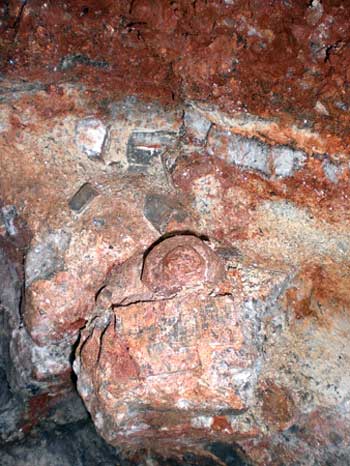 |
| Gem pocket indeed. A close-up view of the mineralized zone. Notice the white clevelandite plate running horizontally in the upper-middle of the photo; clay above and several beryl crystals below. (Photo: Jason Stephenson) |
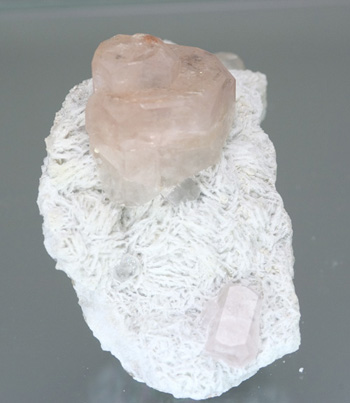 |
| Morganite on clevelandite. This beautiful morganite crystal measures 6 cm. on a bright white bed of clevelandite. (Photo: Jason Stephenson) |
Above you can see the before-and-after of “the nipple,” a unique morganite crystal that seemed to be the center of attention on the new surface of the pocket. The pocket is estimated to be twelve feet long so far and has fluctuated in width from a couple of feet to eight feet at the present. The amazing thing is that the 49er pockets still show promising signs of continuing into the mountain. Hopefully we will be seeing more beautiful beryl specimens in the near future.
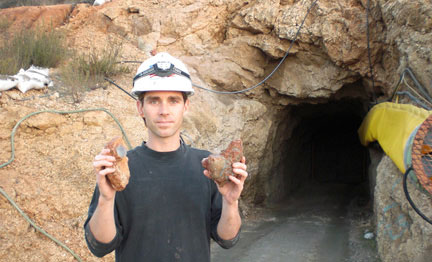 |
| The miners emerge. Jason Stephenson holds the day’s freshly dug treasures in the light of day. (Photo: Bill Larson) |
The job had just begun, on the other side, to trim and beautify the specimens. Bill and John have a few decades under their belt when it comes to this esoteric art. Bill started right in on the first piece using the saw to trim away the excess matrix, accentuating the full form of the crystal. Pala has become the chosen agent to prepare these specimens for display and was given the rights to sell 19 choice pieces. We will be displaying the new specimens in Tucson next month.
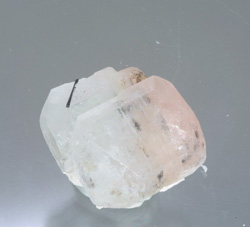 |
| Bi-color beryl. Half aquamarine, half morganite, this beautifully colored crystal is doubly terminated with some schorl inclusions. (Photo: Jason Stephenson) |
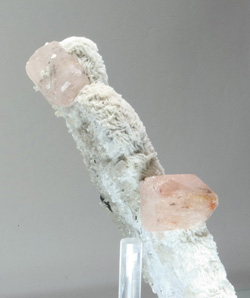 |
| Unusual beryl combo. With two colors of morganite on the same thick plate of clevelandite, this specimen also contain an aquamarine crystal. (Photo: Jason Stephenson) |
Jeff’s hospitality and graciousness made the trip very fun and comfortable. Jeff loves to share his mining experience and even runs group tours every Sunday on location at the Oceanview Mine. The Oceanview is the only mine that carries permits to actually bring the public underground. The operations also have a screening area where the visitors can try their luck in the tailings, which now definitely have some hidden jewels to be found.
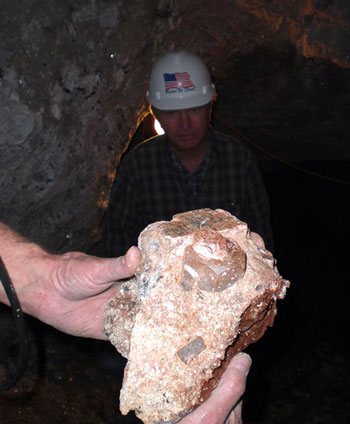 |
| Man and rock. Even John McLean was showing his enthusiasm on the dig. (Photo: Jason Stephenson) |
Another interesting aspect of the beryls being removed from the 49er pocket is the assortment of inclusions being found locked inside the crystals. Many microscopic two-phase inclusions can be seen as well as eye-visible bubbles that move as you rotate the crystal. A few dendrites were found in the formation of branching trees. Also a variety of single-crystal inclusions of quartz, feldspars, and some unidentified pink inclusions.
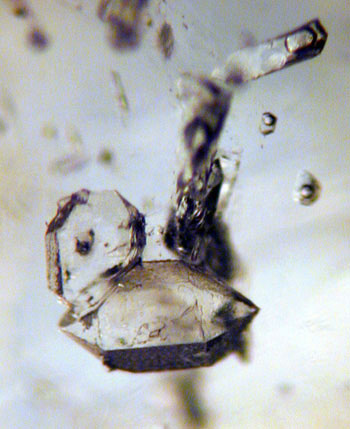 |
| Euhedral quartz crystals in a Japan-law twin-like formation, suggest syngenetic formation with the beryl host. Also notice the two-phase inclusions. (Photo: Jason Stephenson) |
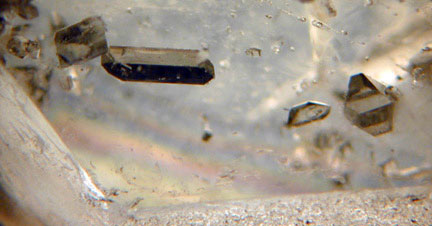 |
| Confetti of single-crystal inclusions, most likely quartz and feldspar, with some small two-phase inclusions. This material also produced some bubbles trapped within negative crystals. (Photo: Jason Stephenson) |
Along with all the beryls, a few nice large quartz crystals and clusters were hauled out, some weighing hundreds of pounds. A lot of the material is facetable grade citrine and smoky varieties. See the next generation enjoying the fruits of the Larson lineage, below.
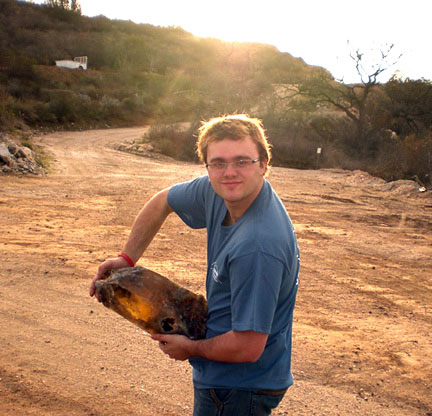 |
| The catch of the day. Will Larson showing off a large citrine crystal. (Photo: Bill Larson) |
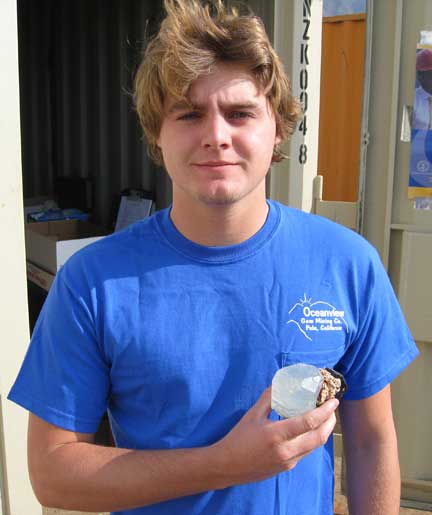 |
| I pledge allegiance to the “Prince.” Carl Larson holding the finest aquamarine specimen, named “The Prince,” dug from the 49er pocket. Wearing his new Oceanview gem mine T-shirt. (Photo Bill Larson) |
Information on gem tours and digging available through the The Oceanview Gem Mine. [back to top]
AGTA: More on Glass-Filled Rubies
Can you call it ruby? Lead content of glass filling raises red flag
Last Friday, the American Gem Trade Association Gemological Testing Center (AGTA-GTC) provided more information on glass-filled rubies. The article’s title says it all: “Glass-filled Rubies More Common in US Market.”
Recalling the old advertising question, Where’s the beef?, the article mentions that “[i]n one specimen seen in Thailand, glass appears to form a significant portion of the specimen, raising the question of whether or not the piece could even be considered to be ruby.”
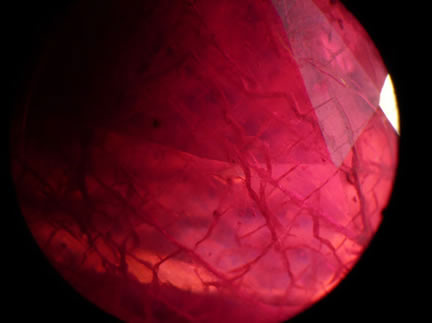 |
| Glass-filled fractures in this photograph look like blood vessels contained in the retina of the eye. (Photo: Lore Kiefert, courtesy AGTA-GTC) |
Because the filling contains lead (Pb), the article reminds jewelers that care should be taken when working with material suspected of containing such filler. Heating such treated stones can release Pb, as can polishing and cutting. (Note: If the “Further reading” link at the end of the article doesn’t load for you, try this one.)
For an overview of how jewelers can avoid damage to ruby and sapphire—enhanced or not—see this MSJA Journal article, “The Hard Facts of Sapphire & Ruby.”
See also last month’s article on lead-glass filled rubies.
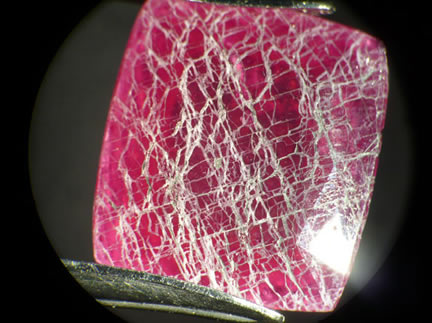 |
| Crackle effect. The jeweler who resized the ring in which this stone was mounted was in for a shock when the glass filling was damaged. Heating lead glass-filled stones can result in exposure to the Pb on the part of the jeweler. (Photo: Lore Kiefert, courtesy AGTA-GTC) |
[back to top]
Jade from Qinghai Used in Olympic Medals
Olympic medals presented at the 2008 Olympic Games in Beijing will incorporate jade from the province of Qinghai, on the northeastern area of the Tibetan Plateau, in western central China, according to a January 1 story from the official Xinhua News Agency.
 |
| Jade bands like these will be incorporated in this summer’s 2008 Olympic medals—white for the gold, light green for the silver, and light green for the bronze. (Photo: Xinhua News Agency) |
This is the first time that non-metal materials will be used in such medals, according to Xinhua, but one of our readers recalls lead crystal or polished glass being incorporated into the medals presented at the 1992 Winter Olympics in Albertville, France.
“We had the donation ceremony this afternoon,” said [province vice governor] Jidi Majia. “Qinghai will donate a great deal of manufactured jade bands to BOCOG. The jade will come from a Kunlun Mountain area which locates in Ge’ermu city.”
“Qinghai has abundant reserve of jade. We will select the best manufacturer to ensure the quality,” he added.
A Friends of Jade article on the medals questioned whether the 6,000 medals required would employ Chinese jade exclusively. Friends of Jade also has articles on Ge’ermu jade (such as this one).
The Olympic Games open August 8 (at 8:00 p.m.—8/8/08 at 8). See the story for more details and photos. [back to top]
Industry News
Radiation Safety Consultant Addresses Blue Topaz
RIT expert says blue topaz stocks are safe
 |
Last fall, JCKonline articles by Gary Roskin carried two remarks by Dr. Andrew Karam, of Rochester Institute of Technology, regarding the safety of irradiated topaz. Dr. Karam has worked as a radiation safety consultant as part of the Nuclear Regulatory Commission’s (NRC) recent efforts to address the irradiation issue. In response to a September 11 story on the subject, Dr. Karam posted the following.
I’ve been working on the NRC and state licensing issues with a company that imports a lot of blue topaz. There are a few things about this that are worth pointing out: First, I’ve gone through the scientific literature, I’ve seen radiation safety reports from the producers, and I’ve done a lot of calculations of radiation dose rates. With all of this, I think it’s safe to say that there is NO RISK to anyone from blue topaz. No risk to the importers, no risk to the shippers, and no risk to anyone wearing the jewelry.
Dr. Kumar went on to explain in a nutshell the regulatory and bureaucratic process of licensing distributors who can validate the safety of irradiated material.
Dose example
In a November 1 article, Dr. Karam gave an example of the dose of radiation obtained by wearing jewelry containing irradiated gemstones.
[Dr. Karam] says a blue topaz bracelet with 6.00 cts. of reactor-irradiated gemstones would produce a radiation dose between 700 and 800 mrem (millirems) if worn continuously for a year after being irradiated but notes that’s less than regulatory limits. “This level of radiation exposure poses no risk to the wearer,” Karam says. “They will not get radiation burns, they will not get cancer, and they don’t have to worry about radiation affecting a pregnancy.”
Regarding jewelry industry workers, Karam used the example of a worker spending 1,000 hours annually “in an area with huge quantities” of blue topaz. According to the article, this scenario “would still be far from a level of exposure that’s likely to cause cancer or any other ill effects.”
The dangling conversation...
In a song written for a 1966 Simon and Garfunkel album, Paul Simon writes of how “we speak of things that matter,” but ultimately, “we are verses out of rhythm / couplets out of rhyme.” Lost in the dangling conversation.
We’re reassured by NRC regulatory action and likewise by Dr. Karam’s remarks. But, of course, NRC statutes and an expert’s dosage estimates don’t address (and plainly aren’t meant to address) the issue of worker safety abroad—during the handling, cutting, and polishing of irradiated material. We’ve come a long way in thirteen months. But we can’t ignore the fact that the conversation remains open, dangling.
For more background on this issue, visit Palagems.com. [back to top]
Burma Bits
Burma Announces 2008 Sales
» First Sale of Year Held January 15–19
In late December, the official Union of Myanmar Economic Holdings Ltd. (UMEHL) announced a gems and jade sale to be held in mid-January, according to the weekly, The Myanmar Times. It is the company’s 24th such sale, the last occurring in August 2007. (See details at the UMEHL website.)
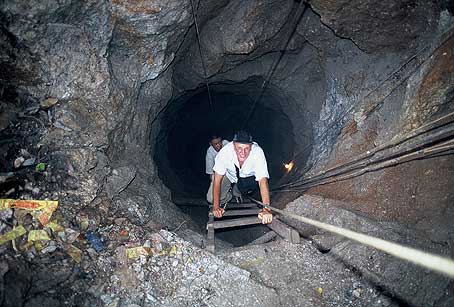 |
| Mining in Mogok. Richard Hughes exiting a loodwin in Burma’s Mogok Stone Tract. (Photo © Richard W. Hughes) |
The UMEHL sale is a relatively small one. Today’s edition of the government daily, New Light of Myanmar, reports attendance of only 637 merchants—roughly 20 percent of the number at November’s sale. In contrast to that sale’s 5,000+ jade lots, the current one will feature just over 1,200, with no floor-price total being mentioned. [back to top]
The Myanmar Times article also refers to an unnumbered sale held by UMEHL that ended December 13, the results of which were not available.
» 45th Gems Emporium Scheduled for March
The 45th Myanma Gems Emporium 2008 is scheduled to be held in March, according to a January 11 article in the official daily, New Light of Myanmar. No other noteworthy details were included in in the article.
Playing with Numbers: A Look at the November Sale Figures
The Myanmar Times article cited above includes a $185 million sales figure for the November 2007 gem emporium—$35 million more than the weekly had reported early last month—based on “independent estimates.” The decline of the US dollar against the euro probably doesn’t explain the discrepancy, but exchange rate confusion might underlie figures that were reported before and after the sale.
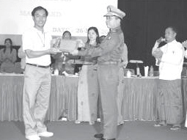 |
| Ma Chun-an receives prize for being jade lot high bidder at November sale. (Photo: NLM) |
On November 27, the day following the sale’s end, official Chinese Xinhua News Agency reported that floor prices for the sale totaled $230 million. That same day, Agence France-Presse (AFP) put the total at “nearly 200 million euros (about 300 million dollars).”
On November 19, while the sale was underway, The Myanmar Times reported floor prices of $300 million (without citing a euro figure). But to muddy the waters, the article claimed that €130 million of the total was for two jade blocks. If the exchange rate on November 19 was €1.4658 to the dollar, €130 million would have equaled $190 million, nearly $30 million more than the $162.5 million ($100 + $62.5 million) quoted in the same article.
In any case, two jade-block whoppers were on offer in November. The day after the sale ended, another AFP article speculated that the more expensive of the two may actually have sold.
The [New Light of Myanmar] newspaper did not say whether that pricey green stone was sold during the auction, but noted the military government “honoured” the highest bidder of jade lots without giving further details.
Well...honoring the highest bidder is a tradition at the conclusion of the sales, so AFP appears to be fishing on this one. And it’s questionable whether the sale of either of the two high-priced jade lots could have been kept under wraps. Even if they had, it likely would have pushed the November sale’s total over $200 million instead of the $185 million most recently reported.
For the record, we’re using the Myanmar Times “independent estimate” of $185 million on our Burma Gem Sales and Statistics.
» Other New Trade Statistics
Our updated Burma Gem Sales and Statistics also features the following figures for Fiscal Year 2006–07:
- Jade Production: 20,458 tons
- Gemstones: 20.879 million carats
- Pearl Production: 240,595 mommes
[back to top]
Burma Trade with China Up 37% Over Last Year
Figures for the first three quarters of fiscal year 2007–08 show that bilateral trade with China was $1.435 billion, up nearly 38 percent over the same period last year, according to the Chinese Embassy in Burma, as reported by the Chinese government’s Xinhua News Agency on December 9.
The statistics lead to China becoming Burma’s second largest trading partner and sixth largest foreign investor. The timeframe via which this claim was made is uncertain, but the article did state that Chinese investment amounted to $638 million, in 30 projects, from 1992 to October 31, 2007. [back to top]
Miners’ Lives and Livings
Workers in Burma find ways of making a living as mining operations close or relocate.
- Los Angeles Times profile of the travails of gemstone, jade, and gold miners and scavengers
- Mizzima News story on the tug-of-war between rebels and military in Phakant, Kachin state—with gold miners in the middle
[back to top]
— End January Newsletter • Published 1/16/08 —
